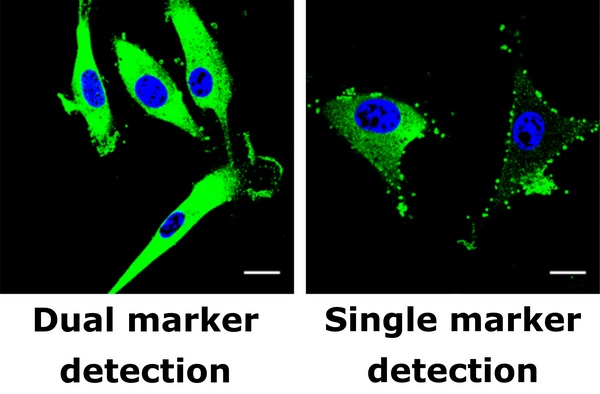Bispecific Antibody Boosts Sensitivity of Brain Cancer PET Scans
By LabMedica International staff writers
Posted on 03 Nov 2015
A bispecific antibody was developed that is taken up by glioblastoma cells in a manner that increases the specificity and intensity of signals detected by PET (positron emission tomography) scanning.Posted on 03 Nov 2015
Investigators at the University of Wisconsin (Madison, USA) used a click chemistry approach to synthesize an antibody that recognized both epidermal growth factor receptor (EGFR) and CD105. Click chemistry generates substances quickly and reliably by joining small units together. It is not a single specific reaction, but is descriptive of a method for generating products that follows examples in nature, which also generates substances by joining small modular units.

Image: Researchers have developed a technique that detects a pair of markers for glioblastoma, a type of brain cancer. Left: Cancerous cells are marked with green (blue shows cell nucleus but does not indicate cancer). Right: When only epidermal growth factor receptor is detected in the same sample, the cancer signal is much less obvious (Photo courtesy of Weibo Cai laboratory, University of Wisconsin).
CD105 (also known as endoglin) has a crucial role in angiogenesis, therefore, making it an important protein for tumor growth, survival, and metastasis of cancer cells to other locations in the body. EGFR is the cell-surface receptor for members of the epidermal growth factor family of extracellular protein ligands. Mutations affecting EGFR expression or activity could result in cancer.
The investigators created a bispecific antibody from CD105 and EFGR specific Fab fragments that also contained a radioactive label detectable by PET. The compound was injected into mice that had received human glioblastoma transplants, and after 36 hours the animals were examined by PET scanning.
Results published in the September 28, 2015, online edition of the journal Proceedings of the National Academy of Sciences of the United States of America (PNAS) revealed a significantly enhanced tumor uptake and tumor-to-background ratio (compared with each monospecific Fab tracer. The combination of highly specific tumor uptake of the signal with extremely low background noise enabled visualization of small tumor nodules (less than five millimeters in diameter).
Senior author Dr. Weibo Cai, associate professor of radiology and medical physics at the University of Wisconsin, said, "As we learn more about cancer and what distinguishes it from healthy tissue we are able to bring to bear our expanding ability to detect and manipulate genes, proteins, and other molecules, both for detection and for therapy."
Related Links:
University of Wisconsin













